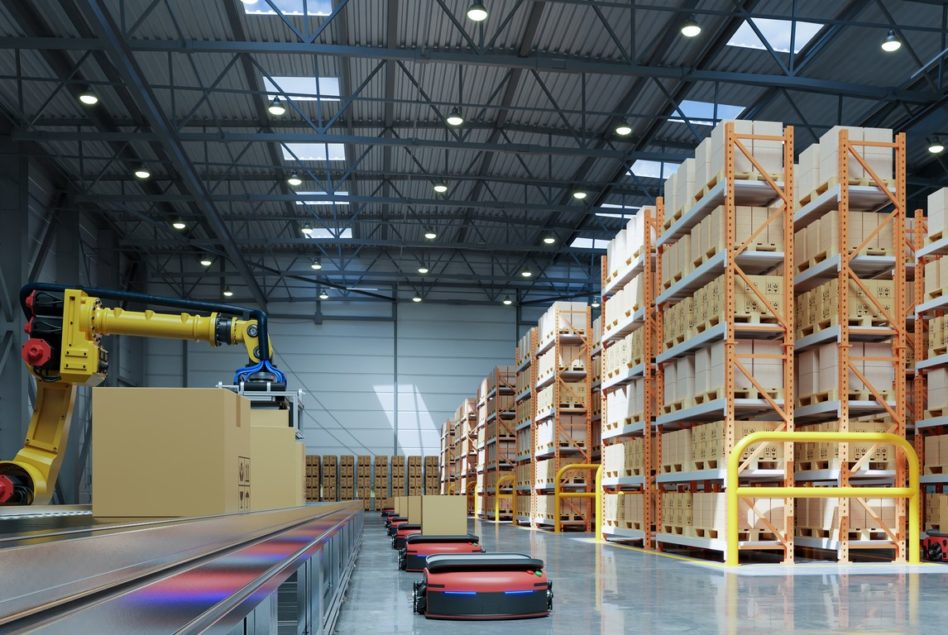
Entering a “dark” warehouse can be an eerie experience. The adjective is almost literal: Who needs lights when there aren’t any people around? All the work is being done by robots, which are guided by sensors and software to pick product from the racks and convey it to the shipping dock in a seemingly endless cycle. To witness the process is to be hypnotized by its numbing regularity.
Yet the system makes eminent sense, given that warehouse work is by its very nature repetitive and, well, robotic. So why not turn the whole thing over to machines?
Dark warehouses have operated for years, especially in regions such as Europe, where the cost of human labor is relatively high. But they remain limited to the handling of certain products that are highly uniform in design and require little variation in order profile. Even warehouses equipped with some of the most sophisticated material-handling systems require the presence of people in some capacity. For the moment, the majority of large distribution facilities seem committed to “collaborative” robots — cobots, in modern parlance — that work side by side with humans.
The future could look quite different. Mehul Patel, chief technology officer of Honeywell Intelligrated, describes progress toward total warehouse automation as a journey — which implies eventual arrival at a final destination.
Until then, Patel suggests, operators might be focusing on robotic hardware at the expense of the software that runs it, and generates the data needed to keep things running smoothly. “The information stack is what people are talking about,” he says. “We need to start getting more into insights.”
Patel is referring to the critical information, derived by from day-to-day operations, that informs the optimal layout of a warehouse and how it operates with the greatest efficiency. Whether it’s about hardware or software, automation needs to focus on three main “pillars,” he says: productivity; the safety, availability and deployment of labor; and sustainability. All are more immediate concerns today than how quickly a warehouse can jettison its people and go “dark.”
Much is made today about the ability of automation to spew out massive amounts of information. “Having the data itself is fine,” Patel says, “but at the end of the day it’s all about generating and creating information that helps you run, optimize and understand your operations.”
Automation has long been touted as the solution to boosting the productivity of manual tasks such as warehouse work. But for the moment, Patel sides with those who believe that, while machines should indeed be taking over more mundane and repetitive tasks, humans need to remain part of the equation.
In addressing all of Patel’s “pillars,” the development of sensor technology is key. In an environment shared by people and robots, the machines need to know where the humans are at all times. Sensors also play a crucial role in identifying where productivity is sagging, and waste is occurring.
When it comes to measuring productivity, Patel is talking about more than those onerous labor-management systems that track how long a worker is taking to perform a given task, right down to the minute, or how many orders are being processed by each individual in a day. Rather than serving as an all-seeing Big Brother, the information generated by sensors can help train workers about the best and safest way to conduct their daily work, he says.
Sensorization also plays a valuable role today in optimizing energy management, by identifying instances of high consumption and predicting where the system is likely to break down due to bottlenecks or failure to maintain equipment. The technology can also direct heating and lighting to where it’s most needed in the facility.
So what does all this have to do with the coming of the dark warehouse? Patel says it’s part of the “continuum” that will culminate in near-total automation at some unspecified date. “Everybody has their own opinion about the timeframe,” he says. “But at the end of the day, it gets us there — to the point where the warehouse will need minimal supervision in running normal day-to-day operations.”
What role people will play at that point is anybody’s guess. Ideally, they will be elevated to higher-skilled positions such as facility design and software creation. Warm bodies will still be needed to make key decisions about product profile and order prioritization — at least until artificial intelligence takes over that task as well.
Ultimately and somewhat ironically, the decision to go dark within a warehouse will be a human one, based on how quickly people are able to adjust to the system, and figure out what they want machines to do (and not do). Says Patel: “It’s all about change management, along with the technology.”


